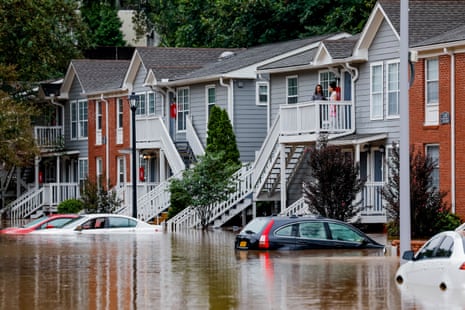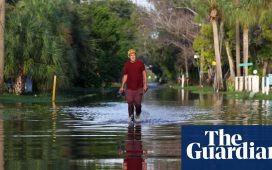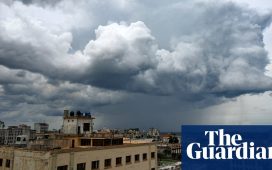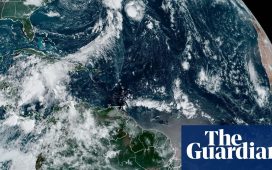Helene’s death toll at least 20 as Georgia first responder killed
Georgia’s governor Brian Kemp says a first responder is among at least 11 people killed in his state, lifting Hurricane Helene’s death toll across the south-eastern US to above 20.
“It is a very dangerous environment, and one of our finest has lost his life trying to save others,” Kemp said a late-morning media briefing.
“We’ve had 11 confirmed fatalities. I would ask all Georgians, like the Kemp family is doing, to keep these folks in these communities in your thoughts and prayers.”

Kemp said emergency crews were “having a hard time getting to places” because of storm damage, and urged residents to be patient.
“We got to get our chainsaw cut teams to continue working to free up roads, but we’ll have those resources moving as soon as it’s safe to do so,” he said, adding that authorities were scanning the state by air to identify the worst hit places.
Overall, Helene has claimed the lives of at least 20 people, according to a Guardian tally. Seven of the reported fatalities are in Florida, with others in North and South Carolina. Several of the deaths are attributed to trees falling on buildings.
Key events
A preliminary assessment of Hurricane Helene’s storm surge in Florida, according to the National Hurricane Center, indicates water levels reached more than 15ft above normal where the storm came ashore near Keaton Beach.
The NHC’s storm surge unit says it will be conducting a detailed analysis in the coming weeks. If confirmed, the figure is about 5ft below the worst predictions for Helene’s storm surge, which officials feared would be 20ft or more.
Preliminary post-landfall modeling of storm surge from Hurricane #Helene indicates areas within the Big Bend region of Florida near Keaton Beach, Steinhatchee, and Horseshoe Beach had water levels reach more than 15 ft above ground level.
— NHC Storm Surge (@NHC_Surge) September 27, 2024
Even so, a surge of 15ft at landfall, and 10ft or more in areas such as Tampa Bay and Fort Myers, Florida, which were much further away from Helene’s eye, is still abnormally high.
For example, the storm surge from category 5 Hurricane Michael, which struck Florida’s Big Bend in October 2018, was only 14ft, but water levels topped above 20ft when the surge combined with waves in the Gulf of Mexico, according to a storm tide sensor near Mexico Beach.
While Helene was downgraded to a tropical storm on Friday morning, another hurricane, Isaac, was forming in the Atlantic.
Although it poses no threat to land, Isaac’s formation means there are three named active storms in the Atlantic basin for the first time since August of last year, according to meteorologist Philip Klotzbach.
Tropical Storm Joyce, currently churning in mid-Atlantic, is not expected to become a hurricane and, like Isaac, poses no threat to land.
August and September are the statistical peak of the Atlantic hurricane season, which began on 1 June and runs until 30 November.
Helene’s death toll at least 20 as Georgia first responder killed
Georgia’s governor Brian Kemp says a first responder is among at least 11 people killed in his state, lifting Hurricane Helene’s death toll across the south-eastern US to above 20.
“It is a very dangerous environment, and one of our finest has lost his life trying to save others,” Kemp said a late-morning media briefing.
“We’ve had 11 confirmed fatalities. I would ask all Georgians, like the Kemp family is doing, to keep these folks in these communities in your thoughts and prayers.”
Kemp said emergency crews were “having a hard time getting to places” because of storm damage, and urged residents to be patient.
“We got to get our chainsaw cut teams to continue working to free up roads, but we’ll have those resources moving as soon as it’s safe to do so,” he said, adding that authorities were scanning the state by air to identify the worst hit places.
Overall, Helene has claimed the lives of at least 20 people, according to a Guardian tally. Seven of the reported fatalities are in Florida, with others in North and South Carolina. Several of the deaths are attributed to trees falling on buildings.
The National Weather Service (NWS) is warning residents near North Carolina’s Lake Lure dam to evacuate immediately because of its “imminent failure”.
The dam, at a hydro-electric plant in Rutherford county, is already overtopping with an excess of water from Hurricane Helene, threatening the safety and effective operation of the dam and hydro plant, according to its website.
Lake Lure, a popular spot for water-based recreation, covers 720 acres and holds billions of gallons.
The evacuation order came in an emergency alert posted by the NWS to X. “Dam failure imminent! Residents below the dam need to evacuate to higher ground immediately,” it said in the all-caps message.
Five reported dead in Florida’s Pinellas county
The sheriff of Florida’s Pinellas county, Bob Gualtieri, said at least five people were killed in separate locations at the height of the storm. He said a storm surge of more than 8ft left parts of the county looking like “a war zone”.
“Not everybody evacuated, and unfortunately, they called for help, and we couldn’t help a lot of the people who called as those conditions got very bad last night, and it was inaccessible,” he told reporters at a morning briefing, reported by CNN.
“We tried to launch boats, we tried to use high water vehicles, and we just got with too many obstacles, and we couldn’t get out there and effect some of those rescues.”
At least two of the deaths were drownings, Gualtieri said, but all five were attributable to the storm. He said it was possible the county’s death toll would rise as deputies went house to house.
“I can’t think of a time ever that Pinellas county has experienced the surge that we experienced last night and into the early morning,” he said.
North Carolina governor: Helene ‘one of worst storms in modern history’
We’ve just heard an update from Roy Cooper, North Carolina’s governor, about the ongoing impact of Tropical Storm Helene. He says the storm is “one of the worst in modern history”.
Two people are confirmed dead in his state, he said in a video briefing to reporters. Heavy rain, flash flooding and downed trees blocking roads continue to hamper rescue and recovery efforts, while almost 900,000 customers in the state are without power:
This is one of the worst storms in modern history for parts of western North Carolina. The end of the rain is not the end of the threat. This fierce storm will move out of our state in the next 24 hours, but the danger will not be over.
Tropical storm force winds that border on hurricane strength are happening right now. Across western North Carolina, trees are falling, causing widespread power outages.
Our hearts are heavy as we report two deaths, one in Catawba County due to a motor vehicle collision on a flooded roadway, and one in Charlotte due to a tree falling on home. There will be more.
Jane Castor, the mayor of Tampa, Florida, took a helicopter ride with the city’s police department at first light Friday to evaluate the flooding and damage caused by Hurricane Helene’s historic storm surge that inundated parts of Tampa Bay.
“We’re seeing extensive damage on Davis Islands and waterfront areas. The National Guard has activated to help with rescue efforts,” Castor wrote in a tweet.
Hurricane center warns of ‘historic and catastrophic flooding’
The center of what is now Tropical Storm Helene passed into North Carolina on Friday morning as forecasters warned of continuing “historic, catastrophic and life-threatening flash and urban flooding” across the south-eastern US.
In its 11am ET advisory, the National Hurricane Center said the storm’s maximum sustained windspeed had weakened to 45mph, far below the 140mph category 4 monster than slammed into Florida’s big bend area on Thursday night.
But they said Helene still posed a significant danger as its forward speed slowed and it dumped almost unprecedented amounts of rain over a wide area.
“Widespread significant river flooding is ongoing, some of which will be major to record breaking,” John Cangialosi, the NHC’s senior hurricane specialist, said.
“Damaging wind gusts will continue over portions of Georgia, the Carolinas, Tennessee, and Kentucky today, particularly over the higher terrain of the southern Appalachians.
“The expected slow motion could result in significant flooding over the Ohio and Tennessee Valleys, and over the southern Appalachians through the weekend.”
Atlanta’s mayor, Andre Dickens, has urged residents to stay home as rescue crews continue operations to reach those stranded by rising floodwaters.
First responders had conducted dozens of rescues and plucked at least 25 people to safety, many from rooftops, he said. A flash flood warning is still in effect for the city.
The Georgia governor, Brian Kemp, has just been on Fox News to reinforce the message:
We still have people trapped in homes that we’re trying to cut our way into. We have a lot of resources on the ground already, we’re calling up additional National Guard, and we’re going to throw everything we got at it.
Kemp said metro Atlanta appeared to have been spared significant wind damage. Several hospitals in southern Georgia were without power after Hurricane Helene knocked out backup generators, he said.
A Georgia resident has spoken of her terror as a giant oak tree crashed through her home at the height of the storm.
Rhonda Bell and her husband spent a sleepless night in the downstairs bedroom of their century-old home just outside Valdosta, Georgia, the Associated Press reported.
The winds broke off tree limbs, tore away neighbors’ roof shingles and knocked down fence panels in the neighborhood with train tracks along one edge. Then an oak tree smashed through the roof of an upstairs bedroom and collapsed onto the living room below.
“I just felt the whole house shake,” Bell said. “Thank God we’re both alive to tell about it.”
Here is a selection of images sent to us over the news wires of the devastation caused by Hurricane Helene’s deadly rampage across south-eastern US:
Nasa says a crew of astronauts is set to launch from Florida’s Kennedy Space Center on Saturday after engineers determined Hurricane Helene had caused no show-stopping damage.
Like many parts of Florida, the Cape Canaveral facility was lashed by tropical storm force winds on Thursday and overnight as Helene made its way north.
Normal operations at KSC resumed Friday, and launch of Crew 9 to the International Space Station, aboard a SpaceX Falcon 9 rocket, is set for no earlier than 1.17pm Saturday, the space agency said in a tweet.
Kennedy has returned to normal operations following Hurricane #Helene.
NASA’s SpaceX #Crew9 mission is targeting launch at no earlier than 1:17 p.m. EDT Saturday, Sept. 28, from Space Launch Complex-40. pic.twitter.com/9mcDe3J6Yc
— NASA’s Kennedy Space Center (@NASAKennedy) September 27, 2024
At least 4.2m without power in south-eastern US
The number of customers without power in the south-eastern US had risen to 4.2m by 9am ET, according to poweroutage.us.
Almost 1.4m of those are in South Carolina, with Florida and Georgia also each topping one million, the site reported. Elsewhere, large areas of North Carolina, and some parts of Tennessee, are out.
DeSantis: rescues ‘saved a lot of lives’ in Florida
Rescue crews in Florida performed “thousands of missions” and “saved a lot of lives” overnight, Ron DeSantis just told a media briefing:
As soon as it was safe to do, and even in many cases [when it] probably wasn’t perfectly safe, search and rescue operations were conducted to help people in distress and transport them to safety.
These missions continue, but we’ve had thousands of missions successfully completed in the overnight hours throughout the state. This is our local first responders in conjunction with state assets, and state assets directly going in and effectuating rescues, that’s the National Guard, that’s Florida Fish and Wildlife.
The Florida governor said that despite “a really historic storm surge” in many areas, including Tampa Bay, he was not aware of any fatalities from rising water:
They’re going to be doing broader search and rescue in those areas that did get hit, and see if there’s any other problems, or if there’s any folks that are still left behind. But as of now, we don’t have reports of that, and so those missions were successful, and those missions saved a lot of lives.
The governor said a second reported Florida death from Helene came in Dixie county when a tree fell on a house. Another person was killed in a traffic incident on Thursday night, he said.
Helene’s reported death toll rises to at least 10
Numbers of those killed by Hurricane Helene’s rampage through the south-eastern US continued to rise on Friday. The Atlanta Journal-Constitution reported six people killed just in Georgia.
Two people in Laurens county, and two others in Jeff Davis county, died in incidents involving falling trees, the newspaper said. Two people were killed when a suspected tornado flipped their mobile home, according to the report.
Reported fatalities elsewhere include a four-year-old girl in a storm-related accident, and person killed by a falling tree in their home, both in North Carolina; and two dead in Florida in separate incidents.
Florida’s governor Ron DeSantis is expected to update reporters imminently about the situation in his state.
Some perspective of Hurricane Helene’s strength from veteran meteorologist and hurricane watcher Jeff Masters, who says the storm was the eighth category 4 or 5 cyclone to make landfall in the last eight years.
By contrast, that’s exactly the same number from the previous 57 years combined.
Helene’s Cat 4 landfall gives the U.S. a record eight Cat 4 or Cat 5 Atlantic hurricane landfalls in the past eight years (2017-2024), seven of them being continental U.S. landfalls. That’s as many Cat 4 and 5 landfalls as occurred in the prior 57 years. pic.twitter.com/p4RQapmiLM
— Jeff Masters (@DrJeffMasters) September 27, 2024
My colleague Oliver Milman has this analysis of the effect of the climate emergency on hurricane activity. He writes:
“Not only is the burning of fossil fuels and other human activity the cause of 100% of warming since 1950, scientists say it is also causing hurricanes like Helene to become fiercer and accelerate more quickly.
The average intensification rate of hurricanes today is nearly 30% greater than it was before the 1990s due to a hotter atmosphere and oceans, according to a study published last year. The path of Helene across the Gulf of Mexico has been exceptionally hot this year, with this increased heat made at least 200 times more likely due to human-caused climate change, according to Climate Central.
Read more:


